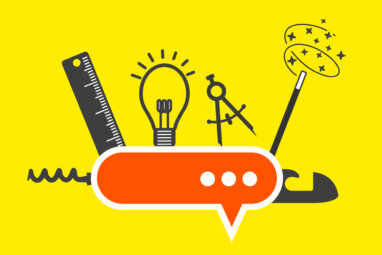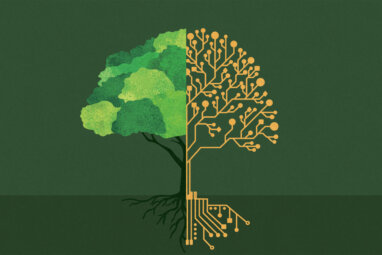Using AI to Help the World Thrive

Topics
Column
What is the purpose of artificial intelligence?
The hype about AI, with its massive potential to disrupt business and society, is likely true. AI could make business radically more efficient and answer questions we didn’t even know we had. Of course, it may also destroy millions of jobs as machines get better than humans at everything from driving trucks to analyzing CT scans.
But focusing for the moment on the upside, it’s worth asking: Could AI help humanity solve its biggest problems?
Consider the challenges in front of humankind. We need to build a thriving economy and world for what the United Nations predicts will be 9.8 billion people by 2050. And we must do it without overwhelming our natural resources or making our climate uninhabitable. We’ll need dramatic changes in how the world works — deep shifts in energy, transportation, buildings, manufacturing, food and agriculture, and much more. We need to answer questions such as:
- What’s the best, most economic path to a low-carbon economy?
- How do we feed 9 billion or 10 billion people on a planet with a fixed amount of arable land?
- How can we best move billions of people around crowded cities to keep those cities functioning, while using the least fuel possible?
- How do we manage an electric grid with huge amounts of intermittent renewable power and billions of smart devices and electric vehicles plugged in?
- How can our economic and political systems enhance well-being for all and reduce inequality?
We may need some serious help answering these kinds of questions. It’s quite possible that we’ve created complex, systemic problems that exceed our human capacity to solve them. In other words, AI may not just be nice to have; we may need it.
Some companies, particularly the tech giants, are recognizing this reality. They’re looking to AI as a tool for solving environmental and social problems.
For example, Google asked its DeepMind AI to examine the “complex, nonlinear” problem of how it uses energy in Google’s data centers (and this is no small issue: just in the United States, the tech sector’s data centers use 70 billion kilowatt hours of electricity at a cost of $7 billion per year). Google’s AI was able to slash energy use for cooling by an impressive 40%, saving significant money and carbon emissions.
In 2014, IBM launched a 10-year, $100 million project to use its Watson cognitive computing system to help Africa solve business and social challenges. The company is also leveraging AI to forecast solar and wind availability for power generation.
Enter Microsoft’s $50 Million “AI for Earth” Program
But perhaps most intriguing is the initiative that Microsoft recently launched — its own big play for leadership in the realm of “using AI to save the world.” In December, the company announced an expanded commitment of $50 million to, as Microsoft President Brad Smith wrote in a blog post, “put artificial intelligence technology in the hands of individuals and organizations who are working to protect our planet.” Smith pointed out that humanity is collecting a vast amount of data on the state of the planet. We need help, he wrote, to “convert it into actionable intelligence.”
The program, dubbed AI for Earth, is finding and funding innovators who are making progress in four critical areas — climate change, water, agriculture, and biodiversity. Microsoft’s first grantees, 35 teams from around the world, are impressive. The AI pioneers include a group in Italy using images of snow in mountains to better predict snow melt and thus water availability; the Jane Goodall Institute, which is helping “identify chimpanzee habitat connectivity and conservation priorities in Africa”; teams at Yale and Cornell using AI and data to understand crop health and improve yields; and a crowdsourced program, iNaturalist, that combines both “citizen-scientist” data with trained scientist input on biodiversity.
Microsoft will accelerate progress by providing seed money, intellectual support (in the form of a multifunctional team of AI and sustainability experts), and technology aid through its cloud computing resources. The AI for Earth program will also identify the initiatives that have the most promise and offer even more aid.
But the goal is more than creating some isolated success stories — it’s about being a catalyst for greater change. The stated mission of Microsoft’s AI efforts is “to empower every person and organization to thrive in a resource-constrained world.”
Rob Bernard, Microsoft’s chief environmental strategist, tells me that with AI for Earth, “we want to light up the ecosystem — we want the market to explode.” He imagines that once a team has created tools for, say, developing high-resolution maps of farmland from satellite imagery, other teams can build on it. They might ask different questions than the initial group, focusing on a different crop. Or look at a completely different problem outside of agriculture that could benefit from the same AI approach.
It’s a great idea. But a critical component of this “explosion of ideas” plan is making some capabilities part of a publicly available platform. So I have to wonder, what’s in it for Microsoft?
Business Payoffs for Being a Leader in Solving the World’s Problems
I see a few primary business benefits.
First, the initiative may help Microsoft attract and retain the best people. The competition for AI talent is intense and the tech giants are paying big bucks. Bernard says that when Microsoft posted some AI for Earth positions, some of the company’s top AI people jumped at the opportunity. There’s a clear trend, especially among millennials, for people to want more purpose in their jobs. Working on big, global environmental challenges is meaningful.
Second, the company can drive revenues for its cloud services. Digitizing the world, which we seem committed to doing, will require lots of data, servers, and software. Putting Microsoft in the middle of that whirlwind is good for business.
Third, the company could yield some related, but harder to measure, intangible benefits. Working on big issues and connecting to cool startups raises the company’s profile and keeps the 40-plus-year-old brand (I know, hard to believe) relevant and modern.
So, this whole movement will be good for humanity and benefit Microsoft (and other tech companies). And that’s more than OK. In fact, it’s critical to the success of the program. We need a large flow of ideas, capital, and talent to solve the world’s biggest challenges. Making it profitable to use AI in the service of humanity will attract more resources to the cause. Again, it’s likely that we need AI. Let’s just hope AI continues to need us.










Comments (2)
Sudhir Kumar
Princeton Blue